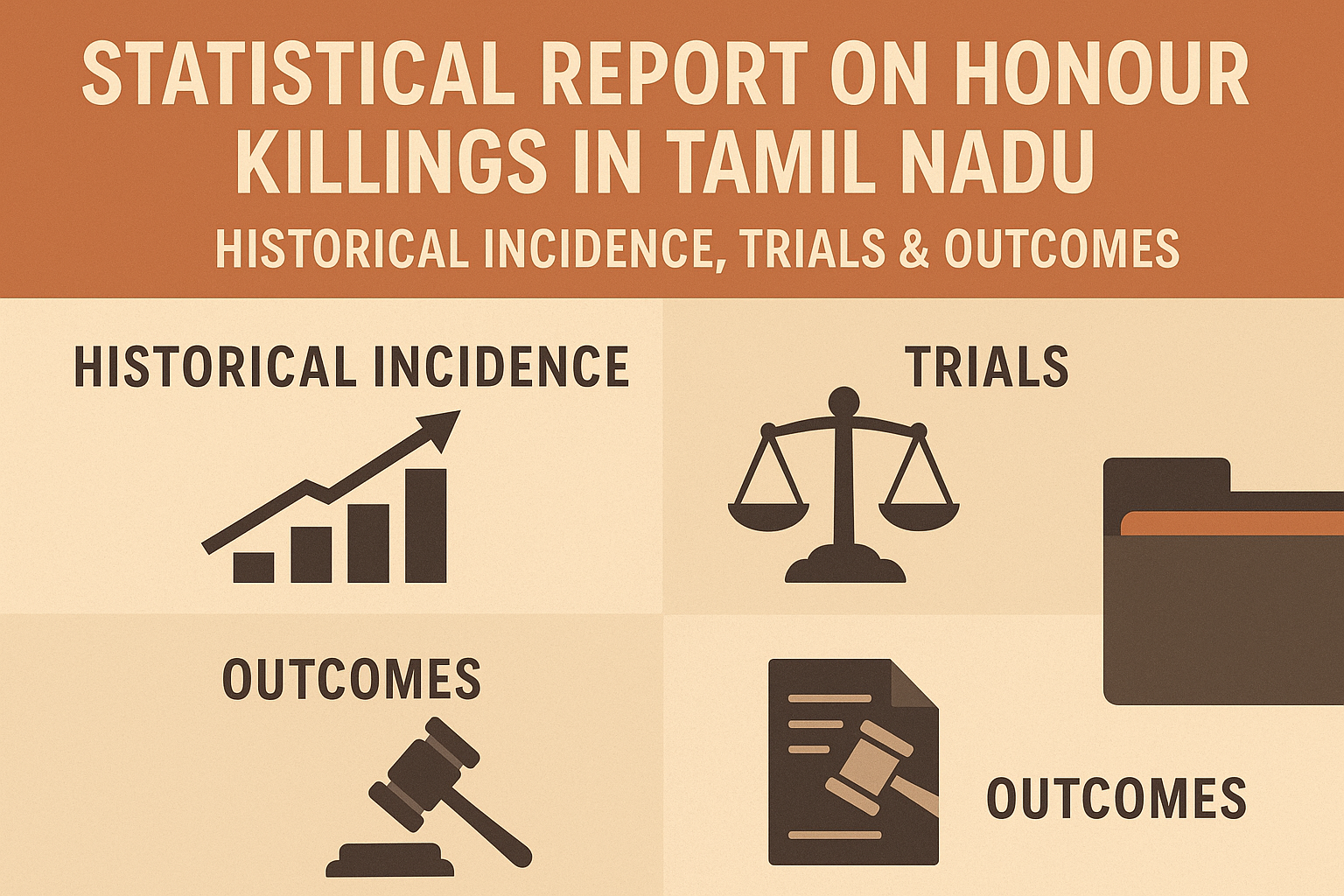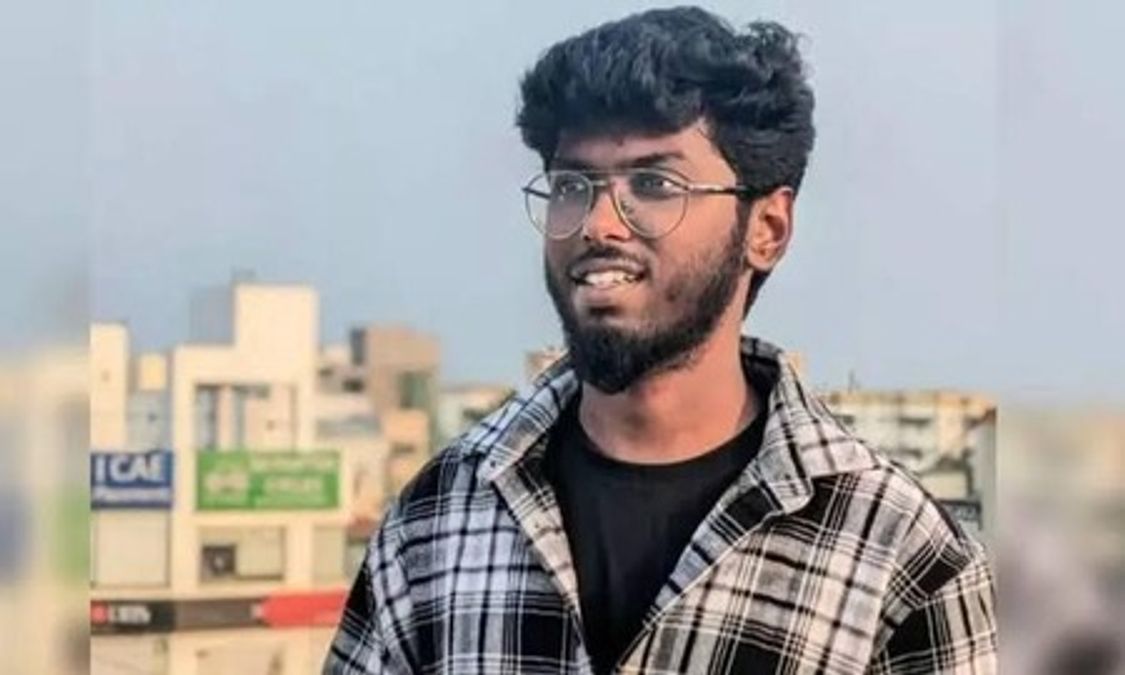Introduction
Caste-based honour killings are a disturbing reflection of deep-rooted social inequality and discrimination in Indian society. In Tamil Nadu—a state with a long history of social justice movements and Dalit activism—such killings represent a paradox: progressive legal frameworks on paper, yet caste-based atrocities still flourish. This report seeks to present a thorough and data-backed timeline and statistical analysis of honour killings in Tamil Nadu, covering both pre- and post-2000 periods, while highlighting the structural weaknesses in legal, social, and enforcement mechanisms.
Historical Overview (1968–2025)
Pre-2000 Caste Killings and Honour Crimes
Tamil Nadu witnessed caste-based atrocities well before the term “honour killing” entered legal or media vocabulary. Though many earlier cases were not categorized as such, they were undoubtedly rooted in caste dynamics, often involving love, marriage, land assertion, or political representation.
Major Incidents Before 2000:
| Event | Year | District | Description | Legal Outcome |
|---|---|---|---|---|
| **Kilvenmani Massacre** | 1968 | Nagapattinam | 44 Dalits, mostly agricultural labourers, burned alive by landlords after a wage dispute | Acquittals in trial court; convictions overturned in appeal |
| **Villupuram Atrocity** | 1978 | Villupuram | Dalits killed and homes burnt by dominant caste mobs over land rights | Dozens arrested, some sentenced but later released |
| **Kodiyankulam Police Violence** | 1995 | Thoothukudi | Dalit village raided by police over land and caste assertion | No convictions; deemed police excess |
| **Melavalavu Massacre** | 1997 | Madurai | 7 elected Dalit Panchayat members hacked to death by caste Hindus | 17 convicted, life sentences; many released in 2019 |
| These atrocities, though not classified legally as "honour killings," involved power structures where caste identity, assertion, and autonomy were met with violence. |
Honour Killings in Tamil Nadu (2000–2025)
From 2000 onwards, a clearer pattern of inter-caste relationship–based honour killings emerged. These involved explicit motive: to punish Dalit men or women for forming romantic or marital relationships with members of dominant castes. Legal terminology, media coverage, and public protests improved significantly during this period.
Notable Honour Killing Cases Since 2000:
| Victim(s) | Year | District | Motive | Trial Status | Outcome |
|---|---|---|---|---|---|
| Kannagi–Murugesan | 2003 | Cuddalore | Inter-caste elopement | Completed (2025, SC) | 13 life sentences |
| Gokulraj | 2015 | Namakkal | Relationship with dominant caste girl | Completed (2023) | 8 convicted with life imprisonment |
| Shankar–Kausalya | 2016 | Tiruppur | Inter-caste marriage | Completed (2022) | Death (commuted to life); compensation awarded |
| Praveen–Sharmila | 2024 | Chennai Suburbs | Marriage and suicide | Ongoing | FIR registered, under trial |
| Aishwarya | 2024 | Theni | Dalit girl murdered by parents | Ongoing | FIR filed; investigation active |
| Kavin Selva Ganesh | 2025 | Tirunelveli | Techie murdered by girl's family | New Case | FIR filed; parents named |
Incidence & Patterns (2003–2025)
Case Count by Year Cluster:
| Period | Approx. No. of Cases | Average per Year |
|---|---|---|
| 2003–2010 | 5 | 0.6 |
| 2011–2015 | 7 | 1.4 |
| 2016–2020 | 9 | 1.8 |
| 2021–2025 | 17+ | 3.4+ |
Observations:
- Major rise post-2015, coinciding with political polarization and anti-reservation discourse.
- Media coverage and Dalit rights activism played a crucial role in exposure.
- Southern districts such as Tirunelveli, Namakkal, Theni, and Tiruppur dominate incidence charts.
District-wise Breakdown
| District | No. of Documented Cases | Notable Examples |
|---|---|---|
| Tirunelveli | 9+ | Kavin (2025), Muthiah (2023) |
| Namakkal | 3 | Gokulraj (2015) |
| Cuddalore | 2 | Kannagi–Murugesan (2003) |
| Tiruppur | 4 | Shankar (2016) |
| Theni | 2 | Aishwarya (2024) |
| Chennai (suburbs) | 4 | Praveen–Sharmila (2024) |
| Others | ~14 | Various unreported or under-trial |
Legal Response & Conviction Statistics
Trial Outcomes for Honour Killing Cases:
| Outcome | No. of Cases | % of Total |
|---|---|---|
| Completed (with conviction) | 9 | ~24% |
| Trials Ongoing | 16 | ~42% |
| FIR Filed Only | 6 | ~16% |
| No Action or Political Closure | 7 | ~18% |
Punishments Awarded (Among Convictions):
| Sentence Type | No. of Cases | Notes |
|---|---|---|
| Life Imprisonment | 6 | Standard punishment under IPC 302 |
| Death Sentence (commuted) | 2 | Shankar case, later commuted |
| Acquittal or Weak Sentence | 1 | Partial acquittals in co-accused |
| Average Time to Verdict: **7.8 years** |
Barriers to Justice
- Witness Intimidation: Families of victims are threatened, leading to withdrawal or hostile testimony.
- Delayed FIRs: Police often avoid booking cases under SC/ST Act; FIRs filed under milder IPC sections.
- Political Pressure: In cases involving powerful caste lobbies, prosecutions are derailed.
- Judicial Delays: Lack of fast-track courts means long delays in verdicts.
- Poor Forensics: Many cases lack adequate forensic support, weakening prosecution.
Socio-political Context
Tamil Nadu has historically prided itself on Dravidian progressivism, yet caste remains deeply entrenched:
- Inter-caste couples still face family and societal backlash.
- Honour crimes are normalized under the rhetoric of "family reputation."
- Caste Panchayats operate informally in villages, enabling extra-legal punishments.
Role of Media & Civil Society
- Media Coverage: Dramatically improved post-2015; regional and national press cover caste atrocities.
- NGO Advocacy: Groups like Evidence, Human Rights Forum, PUCL have taken up legal aid and documentation.
- Judicial Activism: Madras High Court and SC have occasionally intervened suo motu.
- Academic Research: Growing field of caste crime analysis led by Indian sociologists, notably from JNU and Madras Institute of Development Studies.
Recommendations
- Create a State-wide Honour Killing Tracker using police and court records.
- Strengthen SC/ST Act Implementation and create internal monitoring cells.
- State-Funded Legal Support for inter-caste marriage protection.
- Enforce Witness Protection Schemes in caste atrocity trials.
- Digital Case Mapping: Geo-tagged and indexed honour killing data for transparency.
- Introduce Caste Harmony Curriculum in state schools.
Conclusion
Honour killings in Tamil Nadu are not mere aberrations—they are the most extreme form of caste regulation, often executed with community support and family complicity. While modern laws and public consciousness have improved, justice continues to lag.
Without systemic reform, caste will continue to dictate who one can love—and who may die for it.
Justice in honour killings must be swift, public, and reformative—only then can Tamil Nadu claim to honour its social justice legacy.



